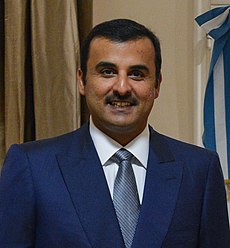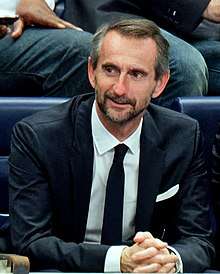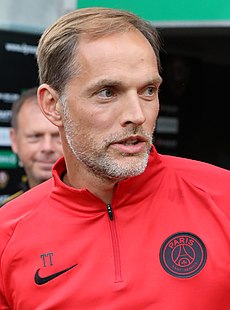Paris Saint-Germain F.C.
Paris Saint-Germain Football Club (French pronunciation: [paʁi sɛ̃ ʒɛʁmɛ̃]), commonly referred to as Paris Saint-Germain, Paris SG, or simply Paris or PSG, is a French professional football club based in Paris. They compete in Ligue 1, the top division of French football. PSG are France's most successful club, having won over forty competitive honours, including nine league titles and one major European trophy. Their home ground is the Parc des Princes.
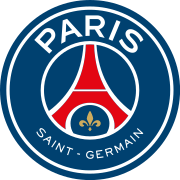 | |||
| Full name | Paris Saint-Germain Football Club | ||
|---|---|---|---|
| Nickname(s) | Les Parisiens (The Parisians) Les Rouge et Bleu (The Red and Blues) | ||
| Short name | PSG, Paris SG, Paris | ||
| Founded | 12 August 1970 | ||
| Ground | Parc des Princes | ||
| Capacity | 47,929 | ||
| Owner | Qatar Sports Investments | ||
| President | Nasser Al-Khelaifi | ||
| Head coach | Thomas Tuchel | ||
| League | Ligue 1 | ||
| 2019–20 | Ligue 1, 1st of 20 | ||
| Website | Club website | ||
|
| |||
| Active departments of Paris Saint-Germain | ||
|---|---|---|
| Football (Men's) | Football (Youth Mixed) | Football (Women's) |
| Handball (Men's) | Esports | Judo (Mixed) |
| Closed departments of Paris Saint-Germain | ||
|---|---|---|
| Boxing (Men's) | Rugby League (Men's) | |
Founded in 1970, PSG won their first major honour, the French Cup, in 1982 and their maiden Ligue 1 title in 1986. The 1990s was among the most successful periods in PSG's history; they claimed their second league crown, three French Cups, two League Cups, two French Super Cups and, most notably, the UEFA Cup Winners' Cup in 1996. After suffering a decline in fortunes during the 2000s, the club have enjoyed a revival since 2011 with increased financial backing; they have clinched seven league titles and eighteen national cups, achieving unparalleled dominance in domestic competitions.
PSG are the club with most consecutive seasons playing in the top-flight and one of only two French clubs to have won a major European title. They are also the most popular football club in France and one of the most widely supported teams in the world. PSG's home kit colours are red, blue and white. The club's crest features the Eiffel Tower and a fleur de lys. PSG have a long-standing rivalry with Olympique de Marseille. The duo contest French football's most notorious match, known as Le Classique.
Tamim bin Hamad Al Thani, ruler of Qatar, owns PSG through state-owned shareholding organization Qatar Sports Investments (QSI), which purchased the club in 2011. The takeover made PSG the richest club in France and one of the wealthiest in the world. As of the 2018–19 season, PSG had the fifth-highest revenue in the footballing world with an annual revenue of €636m according to Deloitte, and are the world's eleventh most valuable football club, worth $1.092b according to Forbes.
History
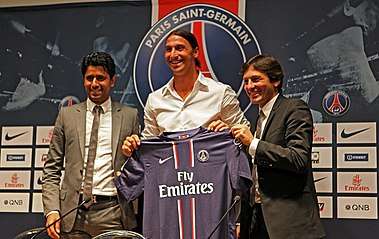
Paris Saint-Germain Football Club was founded on 12 August 1970 after the merger of Paris Football Club and Stade Saint-Germain.[1] PSG made an immediate impact, winning promotion to Ligue 1 and claiming the Ligue 2 title in their first season.[2][3] Their momentum was soon checked, however, and the club split in 1972.[2] Paris FC remained in Ligue 1, while PSG were administratively relegated to Division 3.[4][5] PSG got their revenge in 1974 when they returned to Ligue 1 and Paris FC slipped into the division below.[6] The club also moved into the Parc des Princes that same year.[2][1]
The club's trophy cabinet welcomed its first major silverware in the shape of the Coupe de France in 1982, during a decade marked by players such as Safet Sušić, Luis Fernández and Dominique Rocheteau.[2][1] PSG claimed their maiden league title in 1986, only to decline in subsequent seasons.[7][8] But a takeover by television giants Canal+ revitalised the club and PSG entered their golden era.[7][9] Led by David Ginola, George Weah and Raí, the club won nine trophies during the 1990s.[1][8] Most notably, the Parisians claimed a second league title in 1994 and their crowning glory, the UEFA Cup Winners' Cup in 1996.[2][8]
At the start of the 21st century, PSG struggled to rescale the heights despite the magic of Ronaldinho and the goals of Pauleta.[1] Five more trophies arrived in the form of three Coupe de France, one Coupe de la Ligue and one UEFA Intertoto Cup, but the club became better known for lurching from one high-profile crisis to another.[10][8] Indeed, Paris Saint-Germain spent two seasons staving off relegations that were only very narrowly avoided.[9]
This changed in 2011 with the arrival of new majority shareholders Qatar Sports Investments (QSI).[11] Since the buyout, PSG have signed several stars like Zlatan Ibrahimović, Thiago Silva, Edinson Cavani, Neymar and Kylian Mbappé, and have dominated French football, winning seven of the last eight Ligue 1 titles.[10][12][13] The club has become a regular in the knockout stages of the UEFA Champions League, but has yet to win it.[12][13] Since 2012, PSG has reached the round of 16 each season, and has advanced on to the quarter-finals on five occasions.[14][15] In 2020, PSG made a breakthrough, advancing to the semi-finals for the first time since 1995.[16]
Identity
Colours and mascot
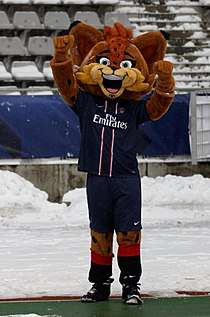
Since their foundation, Paris Saint-Germain have represented both the city of Paris and the nearby royal town of Saint-Germain-en-Laye.[9] As a result, red, blue and white are the club's traditional colours.[17] The red and blue are Parisian colours, a nod to revolutionary figures Lafayette and Jean Sylvain Bailly, and the white is a symbol of French royalty and Saint-Germain-en-Laye.[6][17]
On the club's crest, the Eiffel Tower in red and the blue background represent Paris, while the fleur de lys in white is a hint to the coat of arms of Saint-Germain-en-Laye.[6][17] The fleur de lys is a royal symbol as well and recalls that French King Louis XIV was born in the town.[17] Throughout its history, PSG have brandished several different crests, but all of them have featured the club's three historical colours.[18]
Likewise, PSG's most iconic shirts have been predominantly red, blue or white, with the remaining two colours included as well.[19] The club's official mascot, Germain the Lynx, also sports PSG's traditional colours.[6] It was unveiled during the 2010 Tournoi de Paris in commemoration of the club's 40th anniversary, and can be seen entertaining kids in the stands of the Parc des Princes or near the pitch with the players during the warm-up.[20]
Anthems and mottos
"Allez Paris-Saint-Germain!" was initially a chant sung by PSG supporters during games.[21] It then became the club's official anthem in 1977.[22][23] That year the hymn was recorded by Les Parisiens at the initiative of historical PSG leader and music producer Charles Talar, who produced and released it under his homonym record label.[22][24] A new version to the tune of "Go West" by Village People was recorded in 2010 as part of the club's 40th anniversary celebrations.[6][20] The lyrics were rewritten with suggestions made by fans.[23]
"Ô Ville Lumière" ("Oh City of Light"), to the tune of "Flower of Scotland," is another veritable club anthem.[25][26] PSG gave it official status in 2015 when the club announced it would accompany the players' entry into the field, a tradition which began in 1992 with the song "Who Said I Would" by Phill Collins.[25] Supporters' groups from the Boulogne and Auteuil stands also have several different chants, most notably "Le Parc est à nous" ("The Parc is ours"), "Paris est magique!" ("Paris is magical!") and "Ici, c'est Paris!" ("This is Paris!").[6][27] Both stands began exchanging these chants during PSG matches in the 1990s.[21][28][29] "Paris est magique!" and "Ici, c'est Paris!" are also the club's most iconic mottos or slogans.[6][30][31]
Iconic shirts
| Wikimedia Commons has media related to Paris Saint-Germain FC kits. |
During their first three seasons of existence, the home shirt of Paris Saint-Germain was red with blue and white details in its sleeves and neck to bring together the three colours of the club: the red and blue of Paris, and the white of Saint-Germain-en-Laye.[19][32] During the 2010–11 season, PSG wore a red shirt during home matches to commemorate their 40th anniversary.[33]
The connection between Paris Saint-Germain and the city's fashion houses is a longstanding one. French fashion designer Daniel Hechter became PSG president in 1973 and designed the club's traditional home look that same year: a blue shirt with a red vertical stripe flanked by two thinner white stripes (blue-white-red-white-blue).[32][34] First worn in the 1973–74 season, the so-called "Hechter shirt" has remained the classic home identity of PSG ever since.[19][35][36]
The famous jersey made its debut during a home Ligue 2 game against Red Star on November 10, 1973.[37] This was also the club's maiden match at the Parc des Princes. PSG won 3–1 as Othniel Dossevi scored the club's first goal at the stadium as well as the first with the Hechter shirt.[38] PSG stars from the 1990s and 2000s like Raí, Ronaldinho and Pauleta are associated with this kit. While wearing it, the capital club reached five European semi-finals in a row between 1993 and 1997, claimed the 1995–96 UEFA Cup Winners' Cup and achieved eight consecutive wins against Le Classique arch-rivals Olympique de Marseille between 2002 and 2004.[19][39]
The general belief is that Hechter based his creation on the red-and-white jersey worn by Ajax, the dominant team in Europe at the time, but with the French flag in mind.[32][34][40] Hechter himself has denied this, though, instead claiming he was inspired by the Ford Mustang. He transposed the car's hood stripes on the shirt and employed the three colors of the club.[32] The Hechter shirt has two alternate versions: the "reversed Hechter" (red-white-blue-white-red), introduced in the 1974–75 season, and the "white Hechter" (white-blue-red-blue-white), which premiered in the 1994–95 season.[32][41]
It was with the club's most iconic away outfit, though, that fans saw the first big PSG team which won their maiden Coupe de France titles in 1982 and 1983, experienced their first European campaign in 1983 and claimed their maiden league crown in 1986. The shirt was white with blue and red vertical stripes on the left.[19][35] Like the Hechter jersey, it debuted in the 1973–74 season as the away kit.[32] Promoted by PSG president Francis Borelli, the white shirt became the club's home identity from 1981 to 1990.[35] Now known as the "Borelli shirt," it is synonym with PSG legends from the 1980s like Safet Sušić, Luis Fernández and Dominique Bathenay.[19][36][42]
Crest evolution
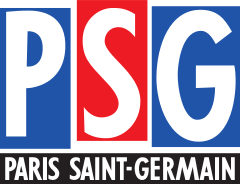
The first crest of Paris Saint-Germain was basically the same as the original Paris FC (PFC) logo. Having to merge and give birth to the club using Stade Saint-Germain's stadium, the PFC crest kept its original design but the name below it changed from "Paris FC" to "Paris Saint-Germain Football Club." This badge consisted of a blue football with a red vessel inside it. The latter is a historic symbol of Paris and is present in the city's coat of arms. The name of the club was written below in red. PSG, however, split from PFC in 1972 and thus needed a new crest.[43]
Representing both Paris and Saint-Germain-en-Laye, the club's second crest became the basis of the one the fans know today. It was a round logo featuring the Eiffel Tower in red against a blue background with two Saint-Germain symbols in white between its legs. These were a fleur de lys and Louis XIV's cradle. The traditional crest was made by a certain Mr. Vallot, designer by profession. It was first used from 1972 to 1982.[43]
The Parc des Princes, the club's home stadium, was added below the crest in 1982 and lasted until 1990. Following a brief return of the traditional crest between 1990 and 1992, former owners Canal+ radically changed it in 1992. The new model had the acronym "PSG" in white against a blue-white-red-white-blue background (like the color pattern of the Hechter shirt) with "Paris Saint-Germain" underneath in white against a black background.[43]
Under pressure from supporters, the traditional crest returned in 1995 with "Paris Saint-Germain" above the tower and "1970" below the cradle. This logo went through a slight facelift in 2002. At the request of the club's Qatari owners, the traditional crest underwent a major makeover in 2013.[43] “Paris” is now written in big white bold letters above a large Eiffel Tower, clearly putting forward the brand “Paris” instead of “Paris Saint-Germain.” Underneath it, “Saint-Germain” is written in smaller letters below the fleur de lys.[30][44] In contrast, the cradle and the club's founding year "1970" were left out.[44] PSG deputy general manager Jean-Claude Blanc said: “We are called Paris Saint-Germain but, above all, we are called Paris.”[30]
Friendly tournaments
Paris Saint-Germain used to host two very famous invitational competitions: the Tournoi de Paris and the Tournoi Indoor de Paris-Bercy.[45][46] Regarded as French football's most prestigious friendly tournament, the Tournoi de Paris is considered a precursor of both the Intercontinental Cup and the FIFA Club World Cup.[45][47] PSG began hosting it in 1975 and were crowned champions a record seven times.[45] Held at the Parc des Princes, the Tournoi de Paris was last organized in 2012.[45][48] On the other hand, the Tournoi Indoor de Paris-Bercy was an indoor football tournament founded by PSG in 1984 and held annually until 1991 at the Palais Omnisports de Paris-Bercy in the 12th arrondissement of Paris. Played indoors (synthetic field and seven-a-side), the competition featured hosts PSG and five more teams. The Parisians lifted the trophy on two occasions, more than any other club.[46]
Grounds
Stadiums
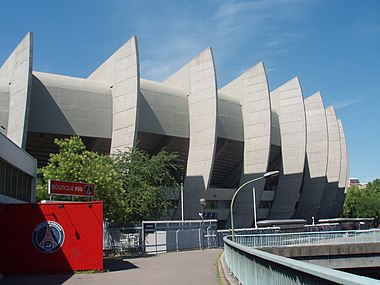
Paris Saint-Germain played their first game at their current home stadium, the 47,929-seater Parc des Princes, against Ligue 2 promotion rivals Red Star on November 10, 1973.[38][49] It was the curtain-raiser for that season's opening Ligue 1 match between Paris FC (PFC) and Sochaux.[38] PSG moved into the ground upon its return to Ligue 1 in 1974, ironically the same year that PFC were relegated. Up until that point it had been the home venue of PFC.[4][50]
During their early years, PSG played at several grounds including the main stadium of the Stade Municipal Georges Lefèvre sports complex, the Stade Jean-Bouin, the Stade de Paris and even the Parc des Princes a few times despite the reluctance of PFC.[51][52] Ever since PSG moved to the Parc, the Stade Georges Lefèvre's artificial turf and grass football pitches have hosted training sessions and home matches for the club's youth academy sides.[52][53] The complex is located in Saint-Germain-en-Laye, just across the street from the Camp des Loges, the club's training center.[53]
Training facilities
Located in Saint-Germain-en-Laye, the Camp des Loges has been the club's training ground since 1970.[54] Construction of a new Camp des Loges, on the same site as the old one, began in January 2008. At a cost of €5m, it was inaugurated in November 2008.[55] In 2013, the venue was renamed Ooredoo Training Centre as part of a sponsorship deal with Ooredoo.[56]
The Paris Saint-Germain Training Center will be the new training ground and sports complex of Paris Saint-Germain.[57][58][59] It will replace the Camp des Loges upon its completion in 2022.[60] Owned and financed by the club, the venue will bring together PSG's male football, handball and judo teams, as well as the football and handball youth academies.[57][60] The club, however, will remain closely linked to their historic birthplace in Saint-Germain-en-Laye as the Camp des Loges will become the training ground of the female football team and academy.[61][62]
Support
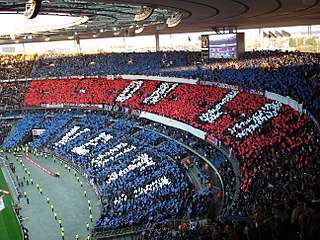
Paris Saint-Germain is the most popular football club in France and one of the most widely supported teams in the world.[63][64] Famous PSG fans include former French President Nicolas Sarkozy and retired NBA player Tony Parker.[65]
Lacking a big passionate fanbase, the club began offering cheaper season tickets to young supporters in 1976.[27][66][67] These fans were placed in the Kop K, located in the K section of the Borelli stand at the Parc des Princes.[67][68] Following an increase in ticket prices, Kop K supporters moved to the Boulogne stand in 1978, and the Kop of Boulogne (KoB) was born.[67][69] There, the club's first Italian-style ultra group, Boulogne Boys, was founded in 1985.[69] Other KoB groups, however, took British hooligans as dubious role models and violence rapidly escalated.[66] PSG supporters' groups have been linked to football hooliganism ever since.[69]
PSG owners Canal+ responded in 1991 by encouraging and financing non-violent fans of the KoB stand to take place in the Auteuil stand at the other end of the Parc des Princes. The Virage Auteuil was born, alongside Supras Auteuil, its most notorious ultras.[70] At first the measure worked but, slowly, a violent rivalry arose between the two stands.[70][71] Things came to a head in 2010 before a match against Olympique de Marseille in Paris. Boulogne fan Yann Lorence was killed following a fight between groups from both stands outside the Parc des Princes, forcing PSG president Robin Leproux to take action.[72][73]
The club exiled the supporters' groups from the Parc des Princes and banned them from all PSG matches in what was known as Plan Leproux.[72][73] It made PSG pay the price in terms of atmosphere, with one of Europe's most feared venues now subdued.[71][73] For their part, former Virage Auteuil supporters formed the Collectif Ultras Paris (CUP) in February 2016, with the aim of reclaiming their place at the stadium.[74] In October 2016, after a six-year absence, the club agreed to their return.[73] Grouped in the Auteuil end of the stadium, the CUP currently is the only ultra association officially recognized by PSG.[73][75] The ultra movement has also started to come back to life in the Boulogne stand. New groups Block Parisii, Paname Rebirth and Résistance Parisienne are trying to convince the club of relaunching the Kop of Boulogne.[76]
Rivalries
Paris Saint-Germain shares an intense rivalry with Olympique de Marseille; matches between the two teams are referred to as Le Classique.[77][78] Equivalent to Spain's El Clásico, the fixture is the biggest rivalry in France and one of the greatest in the world.[79][80] Important security measures are taken ahead of these matches to prevent confrontations between the fans, but violent episodes still often occur when they meet.[77][78]
The duo are the two most successful clubs in French football history and the only two French teams to have won major European trophies.[7][10][81] Moreover, PSG and l'OM were the dominant forces in the land prior to the emergence of Olympique Lyonnais in the 2000s.[77] They are also the two most popular clubs in France and the two most followed French teams outside the country, ahead of Lyon.[63][64][78] Both clubs are at or near the top of the attendance lists every season as well.[78]
In their early meetings during the 1970s there was little indication the two would become deadly adversaries. The newly-formed Parisians were trying to assemble a competitive team, while the Olympians were Ligue 1 contenders. It all changed in 1986, when PSG won its first championship and l'OM were bought by Bernard Tapie.[82] By the end of the decade, PSG were fighting for the 1988–89 title against Tapie's star-studded Marseille, and sparks flew for the first time.[78][83] The accusations made by PSG president Francis Borelli against Tapie and l'OM for fixing matches during that season were a big contributor to their growing antagonism.[84]
However, the 1990s were the real starting point of the rivalry. French TV channel Canal+ bought PSG in 1991 with the aim of breaking Marseille's hegemony, but agreed with Tapie to fuel the animosity between them as a way to spice up the league.[78][83] Now with similar financial power, PSG and l'OM established themselves as top contenders in the title race.[77][85] Both sides were less successful in the late 1990s and throughout the 2000s, but the rivalry remained just as fierce.[77][82] However, since the 2010s, the matchup has been completely dominated by PSG. The investment of their mega-rich Qatar owners has created a wide gap between them and Marseille.[85]
Ownership and finances
During its first three years of existence, Paris Saint-Germain was fan-owned and had 20,000 socios.[1][66] The club was run by board members Guy Crescent, Pierre-Étienne Guyot and Henri Patrelle.[66][86] A group of wealthy French businessmen, led by Daniel Hechter and Francis Borelli, would then buy the club in 1973.[3] PSG changed hands in 1991, when Canal+ took over, and then again in 2006 with the arrival of Colony Capital.[87] Tamim bin Hamad Al Thani, ruler of Qatar, has been PSG's owner since 2011 through state-owned shareholding organization Qatar Sports Investments (QSI).[88]
This means that PSG are one of only two state-owned clubs in the world, along with Manchester City.[89][90] As a result, PSG are also one of the richest clubs in the world.[11] QSI, a subsidiary of the Qatar Investment Authority (QIA), became the club's majority shareholders in June 2011 and sole shareholders in March 2012.[88][87][91] For his part, QSI chairman Nasser Al-Khelaifi has been PSG president since the takeover.[14] Al Thani, however, has the final word on every major decision of the club.[92] He is both the chairman of the QIA and the founder of QSI.[93]
Upon their arrival, QSI pledged to form a team capable of winning the UEFA Champions League and making the club France's biggest name.[8] Consequently, since the summer of 2011, Paris Saint-Germain have spent more than €1 billion on player transfers such as Thiago Silva, Zlatan Ibrahimović, Edinson Cavani, David Luiz, Neymar and Kylian Mbappé.[7][12][13] These massive expenditures have translated in PSG's domination of French football. However, they have not yet brought home the coveted Champions League trophy and have caused the capital club problems with UEFA and its Financial Fair Play regulations (FFP).[10][14][94]
As of the 2018–19 season, Paris Saint-Germain have the fifth-highest revenue in the footballing world with an annual turnover of €636 million according to Deloitte, and are the world's 11th-most valuable football club worth $1.092 billion, according to Forbes magazine.[95][96] PSG's strong financial position has been sustained by the club's lucrative sponsorship deals with several commercial partners, including top sponsors Nike and ALL.[97][98] Throughout their history, though, PSG has rarely been profitable.[99] Prior to the Qatar buyout, the club's cumulative losses between 1998 and 2010 amounted to €300 million.[99][100]
Honours
- As of the 2019–20 season.[10]
Paris Saint-Germain holds many records, most notably being the most successful French club in history in terms of official titles won, with 43.[1][10] Domestically, PSG have clinched nine Ligue 1 championships, a record thirteen Coupe de France, a record nine Coupe de la Ligue, a record nine Trophée des Champions and one Ligue 2 title. In international club football, they have claimed one UEFA Cup Winners' Cup and one UEFA Intertoto Cup.[10] Additionally, PSG have won 24 unofficial titles.[101][102]
Their victory in the 1995–96 UEFA Cup Winners' Cup makes PSG one of only two French clubs to have won a major European competition as well as the youngest European team to do so.[7][103] The Parisians are also the club with the most consecutive seasons in the top-flight (46 seasons in Ligue 1 since 1974–75).[104] Furthermore, PSG are the only side to have won the Coupe de France without conceding a single goal (1992–93 and 2016–17),[105] five Coupe de la Ligue in a row (2014–2018),[106] four back-to-back Coupe de France (2015–2018),[107] and seven consecutive Trophée des Champions (2013–2019).[108]
PSG have won all four national titles in a single season on four occasions. This feat is known as the domestic quadruple. The Red and Blues have completed the domestic double, the league and league cup double, the domestic cup double and the domestic treble several times as well. Therefore, PSG are the club with the most domestic doubles and league and league cup doubles, and the sole team to have won the domestic cup double, the domestic treble and the domestic quadruple.[10][109][110]
Players
Current squad
Note: Flags indicate national team as defined under FIFA eligibility rules. Players may hold more than one non-FIFA nationality.
|
|
Out on loan
Note: Flags indicate national team as defined under FIFA eligibility rules. Players may hold more than one non-FIFA nationality.
|
Youth system
Former players
Hall of Fame
Staff and management
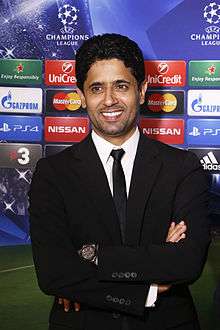
Organizational chart
| Position | Name |
|---|---|
| Owner | |
| Majority shareholder | |
| President | |
| Deputy general manager | |
| Secretary general | |
| Sporting director | |
| Assistant sporting director |
Technical staff
| Position | Name |
|---|---|
| Coach | |
| Assistant coaches | |
| Goalkeeper coach | |
| Assistant goalkeeper coach | |
| Physical preparation manager | |
| Fitness coach | |
| Video analyst |
Performance staff
| Position | Name |
|---|---|
| Performance coordinator | |
| Sports scientists |
Medical staff
References
- "Histoire". PSG.FR. 19 March 2020. Retrieved 19 March 2020.
- "Paris Saint-Germain FC". UEFA.com. 22 August 2012. Retrieved 2 April 2019.
- "La création du PSG de 1970 à 1973". Paris United. 12 November 2018. Retrieved 7 March 2019.
- "Histoire du Paris Saint Germain". PSG70. Retrieved 2 April 2019.
- "Le jour où le PSG a investi le Parc". SoFoot. 13 August 2015. Retrieved 3 April 2019.
- "Things You Should Know About Paris Saint-Germain FC". Culture Trip. 14 December 2016. Retrieved 28 December 2019.
- "Paris city guide". UEFA.com. Archived from the original on 9 July 2016. Retrieved 4 July 2016.
- "A brief history of PSG". ESPN FC. 17 August 2012. Archived from the original on 12 November 2015. Retrieved 18 June 2014.
- "PSG firmly in the pantheon". FIFA.com. 17 October 2008. Retrieved 18 June 2014.
- "Le Palmarès du PSG". Histoire du PSG. Retrieved 6 February 2020.
- "Paris Saint-Germain, having conquered France, are still working on Qatar". The National. 30 December 2015. Archived from the original on 18 April 2017. Retrieved 17 April 2017.
- "Paris Saint-Germain's Qatari owners have spent $1.17 billion on players". CNBC.com. 18 September 2018. Retrieved 7 March 2019.
- "PSG Have Spent €1.17Billion On Players And Still Haven't Got Past Champions League QF's". SPORTbible. 7 March 2019. Retrieved 25 March 2019.
- "PSG's Champions League fortunes won't change until the club changes its zero-sum gamesmanship". Yahoo! Sports. 6 March 2019. Retrieved 7 March 2019.
- "Neymar and Mbappe lead PSG in mocking Haaland celebration". ESPN.com. 12 March 2020. Retrieved 14 March 2020.
- https://edition.cnn.com/2020/08/13/football/psg-neymar-kylian-mbappe-champions-league-atalanta-spt-intl/index.html
- "Le PSG". Saint-Germain-en-Laye. Archived from the original on 6 November 2013. Retrieved 8 July 2013.
- "Blasons, Logos, Écussons du PSG". PSG70. Archived from the original on 11 November 2011. Retrieved 7 October 2010.
- "Paris Saint-Germain, la capitale scintille en rouge et bleu". SO FOOT.com. 28 December 2015. Archived from the original on 17 April 2017. Retrieved 10 April 2017.
- "Le PSG prend un nouveau virage". PSG.FR. 23 July 2010. Archived from the original on 19 August 2017. Retrieved 26 July 2010.
- "Les chants des supporters du PSG en vidéos". PSG MAG. 6 November 2009. Retrieved 28 December 2019.
- "Allez Paris-Saint-Germain". Bide et Musique. 9 February 2003. Retrieved 27 December 2019.
- "PSG: Ecoutez l'hymne des Parisiens chanté par les joueurs !". Sportune. 22 March 2012. Retrieved 27 December 2019.
- "Chronologie". Nouvel Obs. 1 June 2006. Retrieved 10 March 2019.
- "Comment "O Ville Lumière" est en train de pousser Phil Collins vers la sortie". L'ÉQUIPE. 19 December 2015. Archived from the original on 12 April 2016. Retrieved 17 July 2017.
- "VIDÉOS - Les chants les plus emblématiques des supporters dans les stades de foot en France". France Bleu. 20 April 2018. Retrieved 28 December 2019.
- "Kop of Boulogne, the story". SO FOOT.com. 5 March 2010. Retrieved 24 September 2019.
- "PSG Ultràs are bringing the spark back to the Parc". Unusual Efforts. 16 November 2016. Retrieved 6 October 2019.
- "Parc des Princes". The Blizzard. 4 September 2017. Retrieved 27 December 2019.
- "Can Paris Saint-Germain become the world's richest sports club?". Financial Times. 28 March 2014. Archived from the original on 14 July 2015. Retrieved 13 July 2015.
- "Paris is Earning". The Classical. 11 January 2012. Archived from the original on 31 January 2012. Retrieved 13 February 2012.
- "L'historique des maillots du PSG : Les années 1970". Histoire du PSG. 4 May 2020. Retrieved 4 May 2020.
- "L'historique des maillots du PSG : Les années 2010". Histoire du PSG. 8 May 2020. Retrieved 8 May 2020.
- "At P.S.G., a Style Few Clubs Can Match". The New York Times. 3 November 2018. Retrieved 8 March 2019.
- "L'historique des maillots du PSG : Les années 1980". Histoire du PSG. 5 May 2020. Retrieved 5 May 2020.
- "L'historique des maillots du PSG : Les années 1990". Histoire du PSG. 6 May 2020. Retrieved 6 May 2020.
- "Il y a 43 ans, première au Parc des Princes, premier maillot Hechter". PSG Canal Supporters. 10 November 2016. Retrieved 15 July 2020.
- "Millième au Parc des Princes : ces dix matches qui ont fait l'histoire du PSG". Europe1. 9 September 2016. Retrieved 3 April 2019.
- "L'historique des maillots du PSG : Les années 2000". Histoire du PSG. 7 May 2020. Retrieved 7 May 2020.
- "The Crest Dissected – Paris Saint Germain". The Football History Boys. 11 April 2013. Retrieved 2 April 2019.
- "Le grand retour du maillot Hechter blanc !". PSG.FR. 5 August 2020. Retrieved 6 August 2020.
- "L'oeil d'Ambre sur… Le maillot Third". PSG.FR. 16 September 2019. Retrieved 21 July 2020.
- "L'écusson du PSG, évolution du logo à travers notre histoire". Histoire du PSG. 9 May 2020. Retrieved 10 May 2020.
- "PSG dreams bigger with its new brand logo by Dragon Rouge". Dragon Rouge. 22 February 2013. Retrieved 8 March 2019.
- "Anecdotes autour du Tournoi de Paris". PSG.FR. 12 July 2010. Archived from the original on 19 August 2017. Retrieved 23 January 2011.
- "Tournoi Indoor de Paris-Bercy". RSSSF. 5 October 2003. Retrieved 12 August 2018.
- "Há 60 anos, Vasco derrotava o Real Madrid de Di Stéfano em Paris". Globo Esporte. 14 June 2017. Retrieved 4 November 2017.
- "PSG-Barcelone 2–2 : une soirée pleine de promesses". Le Parisien. 4 August 2012. Retrieved 24 February 2017.
- "Parc des Princes". PSG.FR. Archived from the original on 19 August 2017. Retrieved 19 July 2017.
- "A brief history: Paris FC". thefootballcult – Medium. 16 January 2018. Retrieved 2 April 2019.
- "1973 – 1978 : Paris se replace sur la scène française". Paris United. 19 November 2018. Retrieved 7 March 2019.
- "Le PSG et Manchester City, les faux jumeaux". Le Monde. 5 April 2016. Retrieved 2 April 2019.
- "Stade municipal Georges Lefèvre". Saint-Germain-en-Laye. Archived from the original on 19 August 2016. Retrieved 9 July 2016.
- "Le Camp des Loges à St-Germain". 78actu. 26 June 2016. Retrieved 9 July 2016.
- "Présentation du nouveau centre d'entraînement". PSG.FR. 3 November 2008. Archived from the original on 19 August 2017. Retrieved 9 July 2016.
- "Ooredoo, nouveau partenaire du Paris Saint-Germain". PSG.FR. 12 September 2013. Archived from the original on 19 August 2017. Retrieved 9 July 2016.
- "Qu'est-ce que le Paris Saint-Germain Training Center ?". PSG.FR. Retrieved 16 September 2019.
- "Pourquoi le choix du site de Poncy, à Poissy ?". PSG.FR. Retrieved 16 September 2019.
- "Le campus PSG dévoile un nouveau site et de nouveaux visuels". CulturePSG. 25 July 2018. Retrieved 18 July 2019.
- "Le centre d'entraînement du PSG à Poissy sera finalement livré en 2022". Le Parisien. 16 July 2019. Retrieved 18 July 2019.
- "Le PSG choisit Poissy pour son futur centre d'entraînement". Le Parisien. 11 July 2016. Retrieved 18 July 2019.
- "Que deviendra le Centre Ooredoo ?". PSG.FR. Retrieved 16 September 2019.
- "Le PSG est le nouveau club préféré des Français". Onze Mondial. 22 March 2018. Retrieved 12 September 2019.
- "The Top 15 Biggest and Most Supported Football Teams in the World". Zeelo Blog. 19 April 2019. Retrieved 12 September 2019.
- "PSG – OM : Ces stars qui supportent le Paris Saint-Germain". Non Stop People. 17 March 2019. Retrieved 8 April 2019.
- "Histoire des Supporters du Paris Saint-Germain Football Club 1904/2010 (saison par saison)". Ultras Paris!. Retrieved 24 September 2019.
- "1973–1978 : Naissance d'une ferveur". Paris United. 25 November 2018. Retrieved 20 September 2019.
- "Plan du Parc". PSG.FR. Archived from the original on 3 March 2017. Retrieved 2 March 2017.
- "Période 1978 – 1991 : l'ambiance du Parc". Paris United. 7 December 2018. Retrieved 20 September 2019.
- "L'histoire du PSG période 1991–1998 : L'émergence des groupes de supporters". Paris United. 26 December 2018. Retrieved 20 September 2019.
- "L'histoire du PSG 1998–2006 : chaud le Parc !". Paris United. 4 January 2019. Retrieved 20 September 2019.
- "Histoire du PSG période 2006 – 2011, les tribunes : VA-KOB, à la vie à la mort". Paris United. 22 February 2019. Retrieved 20 September 2019.
- "Why the return of Paris Saint-Germain's ultras is such a big deal". ESPN FC. 12 November 2016. Archived from the original on 23 November 2016. Retrieved 22 November 2016.
- "Des groupes contestataires créent le " collectif ultras Paris "". La Grinta. 23 February 2016. Retrieved 24 September 2019.
- "Incidents face à l'Etoile Rouge : qui sont les ultras du PSG ?". Le Parisien. 5 October 2018. Retrieved 30 November 2019.
- "PSG : au Parc de Princes, les ultras tentent de s'imposer côté Boulogne". Le Parisien. 24 September 2019. Retrieved 30 November 2019.
- "France's passion play". FIFA.com. 12 March 2009. Retrieved 25 October 2009.
- "Joey Barton puts the "punch" back into the Marseille-PSG rivalry". Bleacher Report. 4 September 2012. Retrieved 29 July 2013.
- "Du Classico au Classique ?". CulturePSG. 26 October 2019. Retrieved 29 October 2019.
- "The top 50 football derbies on the world 20-11". Mirror Online. 13 April 2018. Retrieved 29 March 2019.
- "Marseille: Histoire du club dans chaque compétition". Footballdatabase.eu. Retrieved 1 May 2020.
- "Marseille vs PSG: France's bitter and violent north-south divide laid bare". FourFourTwo. 1 June 2003. Retrieved 3 November 2017.
- "'A Pistol Against a Tank'—The Ultras' View on the PSG vs. Marseille Rivalry". Bleacher Report. 28 February 2018. Retrieved 10 April 2019.
- "OM-PSG: dix "clasicos" qui ont marqué les esprits". L'Express. 26 November 2011. Retrieved 26 October 2019.
- "'Le Classique', French football's fallen icon". France 24. 16 March 2019. Retrieved 25 October 2019.
- "6 interesting facts you should know about Paris Saint Germain". Discover Walks Blog. 20 August 2018. Retrieved 28 March 2019.
- "Political and Organizational Factors of PSG". Sports and Leisure in France. Retrieved 10 March 2019.
- "Le Qatar sans limite". Le Parisien. 7 March 2012. Archived from the original on 6 December 2016. Retrieved 7 March 2012.
- "Paris Saint-Germain: Can world's richest club rule Europe?". The Independent. 7 August 2012. Retrieved 11 March 2019.
- "PSG v Manchester City emblematic of how Gulf rivals are fuelling football". The Guardian. 5 April 2016. Retrieved 11 March 2019.
- "PSG's Qatari owners tap Neymar to promote QNB". SportsPro Media. 10 December 2018. Retrieved 27 March 2019.
- "Al-Thani, Al-Khelaïfi, Blanc, Henrique : qui dirige vraiment le PSG ?". Le Parisien. 5 May 2018. Retrieved 27 March 2019.
- "Profile: Qatar Emir, Sheikh Tamim bin Hamad Al Thani". BBC News. 25 June 2013. Retrieved 27 March 2019.
- "Football Leaks : les contrats surévalués du PSG version qatarie". Le Monde. 2 November 2018. Retrieved 7 March 2019.
- "Deloitte Football Money League 2020". Deloitte. 14 January 2019. Retrieved 14 January 2020.
- "Paris Saint-Germain on the Forbes Soccer Team Valuations List". Forbes. Retrieved 15 May 2020.
- "Deloitte Football Money League 2014" (PDF). Deloitte. 17 January 2014. Retrieved 22 March 2019.
- "Sponsors". PSG.FR. Retrieved 12 August 2018.
- "Why Paris Saint-Germain's Financial Statements Qualify As Fiction". Forbes. 21 July 2013. Archived from the original on 2 February 2017. Retrieved 25 January 2017.
- "Le PSG a cumulé 300 M€ de déficit depuis 1998". PSG MAG. 30 June 2011. Retrieved 11 March 2019.
- "Listes des saisons". Histoire du PSG. Retrieved 7 July 2020.
- "Trophée national du meilleur public sportif - Football Division II". Collection privée Valjustrotinou. 24 December 2018. Retrieved 16 July 2020.
- "PSG - Rapid de Vienne 1996". PSG70. Retrieved 15 July 2020.
- "PSG, 45 saisons consécutives et nouveau record en Ligue 1". Histoire du PSG. 11 August 2018. Retrieved 11 August 2018.
- "Défense parfaite en Coupe de France : et de 3 pour le PSG !". Histoire du PSG. 4 April 2019. Retrieved 4 April 2019.
- "Le PSG reste au sommet". LFP.fr. 1 April 2017. Retrieved 1 April 2017.
- "Le PSG en Coupe de France : 4 à la suite, record national !". LFP.fr. 8 May 2018. Retrieved 9 May 2018.
- "PSG come from behind to beat Rennes in French Super Cup". The Guardian. 3 August 2019. Retrieved 19 September 2019.
- "Coupe de la Ligue : Les chiffres clés avant PSG-Lyon". Orange Sports. 28 July 2020. Retrieved 4 August 2020.
- "PSG win Coupe de la Ligue to complete domestic quadruple". theScore.com. 31 July 2020. Retrieved 1 August 2020.
- "Équipe Première". PSG.FR. Retrieved 31 August 2019.
- "Tuchel donne ses cinq capitaines du PSG". CulturePSG. 27 September 2019. Retrieved 27 September 2019.
- "PSG : l'arrivée de Leonardo bousculerait l'organigramme du club". Le Parisien. 7 June 2019. Retrieved 13 June 2019.
- "Victoriano Melero officiellement secrétaire général du PSG". CulturePSG. 8 September 2017. Retrieved 13 June 2019.
- "Angelo Castellazzi revient au PSG comme adjoint de Leonardo (L'E)". CulturePSG. 1 July 2019. Retrieved 1 July 2019.
External links
| Wikimedia Commons has media related to Paris Saint-Germain Football Club. |
- Official websites
